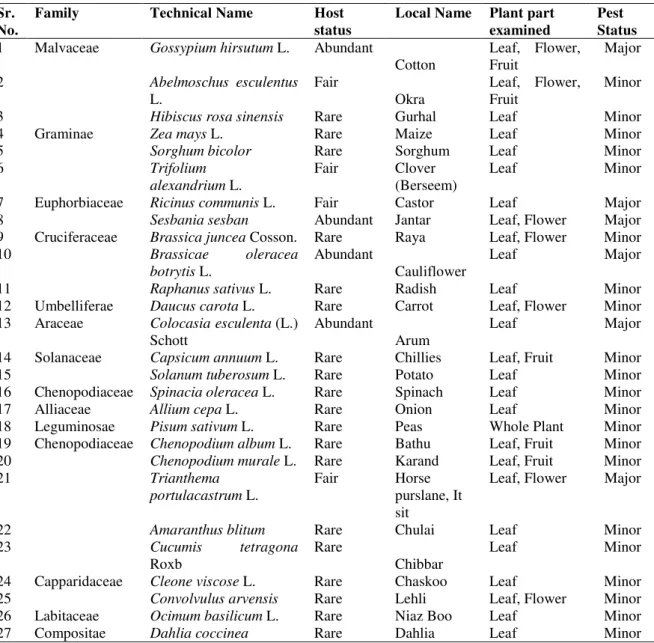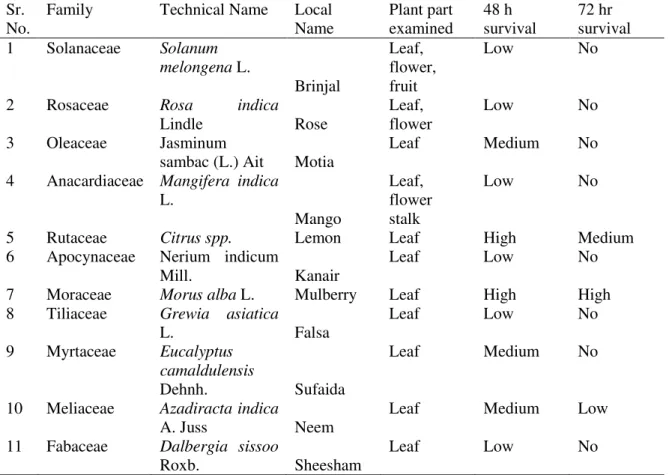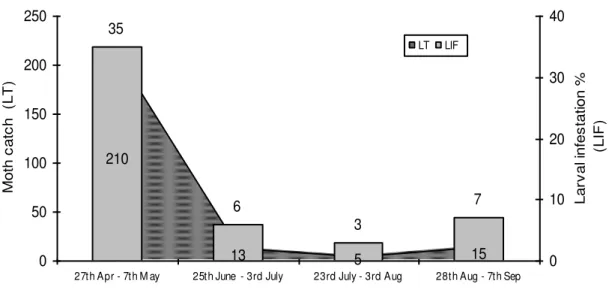HOST PLANTS OF LEAF WORM, SPODOPTERA LITURA (FABRICIUS)
(LEPIDOPTERA: NOCTUIDAE) IN PAKISTAN
Munir Ahmad
1*, Abdul Ghaffar
2, Muhammad Rafiq
21Pir Mehr Ali Shah, Arid Agriculture University, Murree Road, Rawalpindi, Pakistan 2Entomology Section, Central Cotton Research Institute, Old Shujabad Road, Multan Pakistan
ABSTRACT
Spodoptera litura is a notorious leaf feeding insect pest of more than one hundred plants around the Asia-Pacific region. Host plant survey for two years from three different locations in cotton belt revealed 27 plant species as host plants of S. litura belonging to 25 genera of 14 families including cultivated crops, vegetables, weeds, fruits and ornamental plants. Major host plants on which it thrived for maximum period were Gossypium hirsutum L., Ricinus communis L., Brassica oleracea
var. botrytis L., Colocasia esculenta L., Trianthema portulacastrum L. and Sesbania sesban L.. Eggs were also collected from tree plants but larvae did not complete their development. Reliance of S. litura on major plant species of cultivated crops necessitates their regular monitoring especially during March to April for their population abundance and early warning for their management on commercial crops like cotton.
Keywords: Spodoptera litura, host selection, major host plants, host preference
INTRODUCTION
Large host range is considered important for better chance to survive during evolutionary strategies (Simpson et al., 2002; Raubenheimer and Simpson, 2003; Lee et al., 2003). Host plant range of generalist insect pests like S. litura may vary due to their higher level of feeding on different plant species and almost all parts of these plants (Schoonhoven et al., 1998; Suomela, 1996). Host selection may be associated with primary as well as secondary metabolites present in these plants which help them to choose preferred hosts due to nutritional variation (Ehrlich and Murphy, 1988; Rosenthal and Berenbaum, 1992; Simpson et al., 2002; Lee et al., 2003).
In Genus Spodoptera, Spodoptera litura and Spodoptera littoralis are almost similar in their
morphological characters and can be
differentiated on the basis of male and female genitalia. However, S. litura is native to India and South-East Asia (Waterhouse and Norris, 1987). It is considered as one of the most destructive insect pests in Asia-Pacific region because of its high reproductive rate and heavy losses to crops. Larvae feed gregariously on plant leaves and later eat almost every plant part. The behavior of moving like army from one field to another gave its local name as armyworm in Indo-Pak region (Ahmad et al., 2007a).
Eggs are generally laid in batches covered with the tuft of abdominal hair of the moth to protect them from more than 100 species of biocontrol agents (Rao et al., 1993). On hatching, larvae feed in clusters and later disperse through silken threads in third larval instar. Single female moth can lay more than 2000 eggs in her (6-8 days) life span. There may be 3-4 consecutive layers of eggs in a single batch hatching generally in 2-3 days (Waterhouse and Norris, 1987; Hill, 1975, Ahmad, M. personal observations).
Environmental conditions during 2004 and 2005 favored their multiplication and wide spread dispersal on cotton in Punjab and Sindh provinces of Pakistan with heavy losses on cotton. Insecticides were even imported through air freight to manage the shortage of insecticides for its management. On cotton crop, generally 2-3 applications of insecticides at full dose rates are applied to manage this insect pest. Heavy resistance to all conventional and some new chemistry insecticides have also been observed which need proper rotation and wise use of these insecticides for long term benefits in pest management (Ahmad et al., 1997a,b, 2008, 2009; Sayyed et al., 2008, Saleem et al., 2008).
Lack of information on host plants range in the cotton belt urged to conduct a planned study to observe the year-round presence of S. litura
regarding level of insect and to keep under observation its sources of multiplication.
MATERIALS AND METHODS
All plant species found in the cotton growing area with multiple cropping pattern were examined from 2004 to 2006 at fortnightly intervals in a radius of more than 100 km around Multan, Jahanian and Muzaffar Garh districts of Punjab, Pakistan. Depending upon the plant species, the sample size varied from whole plant including leaves, branches, flowers and fruit etc to leaves only because of leaf feeding behavior of S. litura. Status of its presence was estimated on per leaf area basis observing egg and larval stages. To make sample size uniform, larval population of S. litura was converted into 10cm2 leaf area irrespective of shape and size of the leaves of different plant species examined with them. Host plants of S. litura were categorized on the availability of larvae for a longer period as abundant if large number were present in the visited areas. Their less availability was termed as fair in density and plant species harbouring very small number were designated as rare host plant. Larval damage only was not considered as a parameter of host plant consideration. Plants harboring egg batches on them were brought in laboratory to verify their host plant status if S. litura first instar larvae hatching from the same egg batch laid on the specified host. Plant species carrying both egg batches and larvae of all the instars were designated as true host. Plant species carrying S. litura for more than three months were classified as a major host with maximum larval population per 10cm2 leaf surface areas and others not satisfying this condition were termed as minor hosts (Arif et al., 2009).
RESULTS AND DISCUSSION
Leafworm, S.litura was recorded from 34 hosts including cultivated crops, vegetables, weeds, fodder and ornamental plants. There were two of cultivated crop as cotton and maize, eleven of vegetables, nine of weeds, four of fodders and eight were of ornamentals. Early maximum population was observed on arum where it completes at least three non-overlapping
horse purslane, larvae were found from July to October. Due to drastic decrease in major host plants availability and intensive insecticide application on cauliflower from mid-November, it started shifting from minor hosts like weeds, ornamentals and fodders. Sixcrops and vegetables were considered as the major hosts of S. litura whereas others were recorded as minor hosts (Table 1).
The development/population dynamics of S. litura on arum and horse purslane was seen after minimum activity period from November to early April. Interaction between moth catches in light trap coincided with early presence of its larval damage serving as a rich and excessive food resource to multiply (Fig. 1). Weekly observations for moths trapped and field larval infestation data from three different locations revealed that first larval infestation was more than 35% but others were negligence. Moth catches then decreased drastically to a few per day. Later on, second and third moth catches trend was seen after an average of 25– 30 days each but moth number in light trap and % infestation in arum fields decreased drastically. This suggests the direct effect of arum crop on moths ultimately helping in its population build up (Fig. 2). Cauliflower being transplanted in early August to end March remains in the cotton adjacent field around the countryside provides an alternate source for it. Vegetable farmers being more concerned to insect control than cotton growers contribute more to limit the S. litura population (Ahmad et al., 2009; Khaliq et al., 2007).
pests including S. litura. Presence of plant metabolites may also hinder their development but decrease deleterious effects due to gregarious feeding (Simpson et al., 2002; Lee et al., 2003). Different plant species were observed with egg batches which did not even completed their larval development and died earlier (Table 2). These might have been used for forced egg-laying when suitable hosts were unavailable or near to grow out under these tree
species. This aspect further needs to be tested if these mothers select the possibilities of future present of host plants to serve as their progeny development.
It is, therefore, concluded that management of
S. litura on these hosts plants especially arum crop during the non-cotton growing period may reduce its pressure on cotton crop. Recorded host plants contribute in the maintenance of S. litura population abundance and its wide spread management. The pest population and its density largely depends upon the availability of host plants.
Table 1 Plants parts examined for leaf worm, Spodopteralitura infestation during host plants field survey
Sr. No.
Family Technical Name Host
status
Local Name Plant part examined
Pest Status
1 Malvaceae Gossypium hirsutum L. Abundant
Cotton
Leaf, Flower, Fruit
Major
2 Abelmoschus esculentus L.
Fair
Okra
Leaf, Flower, Fruit
Minor
3 Hibiscus rosa sinensis Rare Gurhal Leaf Minor
4 Graminae Zea mays L. Rare Maize Leaf Minor
5 Sorghum bicolor Rare Sorghum Leaf Minor
6 Trifolium
alexandrium L.
Fair Clover
(Berseem)
Leaf Minor
7 Euphorbiaceae Ricinus communis L. Fair Castor Leaf Major
8 Sesbania sesban Abundant Jantar Leaf, Flower Major
9 Cruciferaceae Brassica juncea Cosson. Rare Raya Leaf, Flower Minor
10 Brassicae oleracea
botrytis L.
Abundant
Cauliflower
Leaf Major
11 Raphanus sativus L. Rare Radish Leaf Minor
12 Umbelliferae Daucus carota L. Rare Carrot Leaf, Flower Minor
13 Araceae Colocasia esculenta (L.)
Schott
Abundant
Arum
Leaf Major
14 Solanaceae Capsicum annuum L. Rare Chillies Leaf, Fruit Minor
15 Solanum tuberosum L. Rare Potato Leaf Minor
16 Chenopodiaceae Spinacia oleracea L. Rare Spinach Leaf Minor
17 Alliaceae Allium cepa L. Rare Onion Leaf Minor
18 Leguminosae Pisum sativum L. Rare Peas Whole Plant Minor
19 Chenopodiaceae Chenopodium album L. Rare Bathu Leaf, Fruit Minor
20 Chenopodium murale L. Rare Karand Leaf, Fruit Minor
21 Trianthema
portulacastrum L.
Fair Horse
purslane, It sit
Leaf, Flower Major
22 Amaranthus blitum Rare Chulai Leaf Minor
23 Cucumis tetragona
Roxb
Rare
Chibbar
Leaf Minor
24 Capparidaceae Cleone viscose L. Rare Chaskoo Leaf Minor
25 Convolvulus arvensis Rare Lehli Leaf, Flower Minor
26 Labitaceae Ocimum basilicum L. Rare Niaz Boo Leaf Minor
Table 2 Plants harboring egg batches of leaf worm, Spodopteralituraand their survival rate of hatched larvae
Sr. No.
Family Technical Name Local
Name
Plant part examined
48 h survival
72 hr survival
1 Solanaceae Solanum
melongena L.
Brinjal
Leaf, flower, fruit
Low No
2 Rosaceae Rosa indica
Lindle Rose
Leaf, flower
Low No
3 Oleaceae Jasminum
sambac (L.) Ait Motia
Leaf Medium No
4 Anacardiaceae Mangifera indica
L.
Mango
Leaf, flower stalk
Low No
5 Rutaceae Citrus spp. Lemon Leaf High Medium
6 Apocynaceae Nerium indicum
Mill. Kanair
Leaf Low No
7 Moraceae Morus alba L. Mulberry Leaf High High
8 Tiliaceae Grewia asiatica
L. Falsa
Leaf Low No
9 Myrtaceae Eucalyptus camaldulensis
Dehnh. Sufaida
Leaf Medium No
10 Meliaceae Azadiracta indica
A. Juss Neem
Leaf Medium Low
11 Fabaceae Dalbergia sissoo
Roxb. Sheesham
Leaf Low No
*Survival Rate: Low: 30%; medium: 50-60%, High: 80-90%; No: all dead
Jan Feb Mar Apr May Jun Jul Aug Sep Oct Nov Dec
Cotton
Cauliflower
Arum
Horse purslane
Castor
Jantar
Potato
Moth catch on a light trap with their main activity month periods
Jan Feb Mar Apr May Jun Jul Aug Sep Oct Nov Dec
Fig. 2 Comparison of
S. litura
mean moth catch with larval
infestation on arum crop during 2005-06
210
13 5 15
35
6
3
7
0 50 100 150 200 250
27th Apr - 7th M ay 25th June - 3rd July 23rd July - 3rd Aug 28th Aug - 7th Sep
Peak activity period
M
o
th
c
a
tc
h
(L
T
)
0 10 20 30 40
L
a
rv
a
l
in
fe
s
ta
ti
o
n
%
(L
IF
)
LT LIF
ACKNOWLEDGEMENTS
Authors are thankful for two anonymous reviewers to improve the manuscript. We are also thankful for Director, CCRI, Multan for providing facilities for conduct of this field survey and laboratory insect rearing.
REFERENCES
Ahmad, M., M. I. Arif and M. Ahmad.(2007a) Occurrence of insecticide resistance in field populations of Spodoptera litura
(Lepidoptera: Noctuidae) in Pakistan.Crop Prot. 26: 809-817.
Ahmad, M., A. H. Sayyed, N. Crickmore and M. A. Saleem. (2007b) Genetics of resistance to deltamethrin in a field population of Spodoptera litura
(Lepidoptera: Noctuidae). Pest Manag. Sci. 63: 1002-1010.
Ahmad, M., A. H. Sayyed, M. A. Saleem, M. Ahmad. (2008) Evidence for field evolved resistance to newer insecticides in
Spodoptera litura (Lepidoptera: Noctuidae) from Pakistan. Crop Prot. 27: 1367-1372. Ahmad, M., M. A. Saleem and A. H. Sayyed.
(2009) Efficacy of insecticide mixtures against pyrethroids and organophosphates
resistant populations of Spodoptera litura
(Lepidoptera: Noctuidae). Pest Manag. Sci. 65: 266-274.
Arif, M. I., M. Rafiq and A. Ghaffar. (2009) Host plants of cotton mealybug (Phenacoccus solenopsis): a new menace to cotton agroecosystem of Punjab. Int. J. Agric. Biol.11: 163–167.
Ehrlich, P. R. and D. D. Murphy. (1988) Plant chemistry and host range in insect herbivores. Ecology. 69: 908–909.
Hill, D. (1975) Spodoptera litura (F.) In:
Agricultural Insect Pests of the Tropics and their control. Cambridge University Press, London, UK.
Khaliq, A., M. N. R. Attique, and A. H. Sayyed. (2007) Evidence for resistance to pyrethroids and organophosphates in
Plutella xylostella (Lepidoptera:
Plutellidae) from Pakistan. Bull. Entomol. Res.97: 191–200.
Lee, K. P., D. Raubenheimer, S. T. Behmer and S. J. Simpson. (2003) A correlation between macronutrient balancing and insect host-plant range: evidence from the specialist caterpillar Spodoptera exempta
and diseases of Spodoptera litura (F.) (Lepidoptera: Noctuidae). Insect Sci. Appl.
14: 273-284.
Raubenheimer, D. and S. J. Simpson. (2003) Nutrient balancing in grasshoppers: behavioural and physiological correlates of diet breadth. J. Exper. Biol. 206: 1669– 1681.
Rosenthal, G. A. and M. R. Berenbaum (eds.). (1992) Herbivores: Their Interaction with Secondary Plant Metabolites, 2nd ed. Academic Press, San Diego, California. Saleem, M. A., M. Ahmad, M. Ahmad, M.
Aslam and A. H. Sayyed. (2008) Resistance to selected organochlorine, organophosphate, carbamates and pyrethroid insecticides in Spodoptera litura
(Lepidoptera: Noctuidae) from Pakistan. J Econ. Entomol. 101: 1667-1675.
Sayyed, A. H., M. Ahmad and M. A. Saleem. (2008) Cross-resistance and genetics of resistance to indoxacarb in Spodoptera litura (Lepidoptera: Noctuidae). J. Econ. Entomol. 101:472-479.
Schoonhoven, L. M., T. Jermy and J. J. A. van Loon. (1998) Insect-Plant Biology: From Physiology to Evolution. Chapman and Hall, London.
Simpson, S. J., D. Raubenheimer, S. T. Behmer, A. Whitworth and G. A. Wright. (2002) A comparison of nutritional regulation in solitarious and gregarious phase nymphs of the desert locust,
Schistocerca gregaria. J. Exper. Biol. 205: 121–129.
Suomela, J. (1996) Within-tree variability of mountain birch leaves causes variation in performance for Epirrita autumnata larvae. Vegetation. 127: 77–83.
Waterhouse, D. and K. Norris. (1987)
Spodoptera litura (Fabricius). In:
Biological Control: Pacific Prospects. pp. 250-259. Australian Centre for International Agricultural Research, Canberra.


